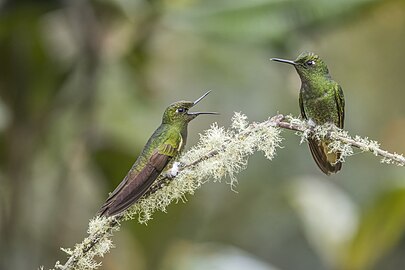Buff-tailed coronet
| Buff-tailed coronet | |
|---|---|

| |
| Boissonneaua flavescens flavescens, Colombia | |
| Scientific classification | |
| Domain: | Eukaryota |
| Kingdom: | Animalia |
| Phylum: | Chordata |
| Class: | Aves |
| Clade: | Strisores |
| Order: | Apodiformes |
| Family: | Trochilidae |
| Genus: | Boissonneaua |
| Species: | B. flavescens
|
| Binomial name | |
| Boissonneaua flavescens (Loddiges, 1832)
| |

| |
The buff-tailed coronet (Boissonneaua flavescens) is a species of hummingbird in the "brilliants", tribe Heliantheini in subfamily Lesbiinae. It is found in Colombia, Ecuador, and Venezuela.[3][4]
Taxonomy and systematics
The buff-tailed coronet shares genus Boissonneaua with two other coronets, the chestnut-breasted (B. matthewsii) and velvet-purple (B. jardini). It has two subspecies, the nominate B. f. flavescens and B. f. tinochlora.[3]
-
B. f. flavescens
Colombia -
B. f. flavescens
Colombia -
B. f. flavescens
Colombia -
B. f. tinochlora
Ecuador
Description
The buff-tailed coronet is 11 to 12 cm (4.3 to 4.7 in) long and weighs 7.3 to 8.8 g (0.26 to 0.31 oz). Both sexes have a short, straight, black bill and a small white spot behind the eye. Males of the nominate subspecies are mostly shining green, with a buff belly spotted with green. The underwing coverts are cinnamon and show in flight. The central tail feathers are bronzy and the rest buff with bronze tips and edges. It has small white tufts on the legs. The nominate female has more buff on the underparts and the bronze of the tail is less extensive. The buff parts of both sexes of B. f. tinochlora have a cinnamon cast and there is more bronze on the tail feathers' tips.[5]
Distribution and habitat
The nominate subspecies of buff-tailed coronet is found from the Andes of western Venezuela's Mérida state south and west through all three Andean ranges of Colombia. B. f. tinochlora is found from southwestern Colombia south along the west slope of the Andes as far as Cotopaxi Province in central Ecuador and also in a few places on Ecuador's eastern Andean slope. The species inhabits the interior and edges of humid to wet montane forest, cloudforest, and elfin forest. It also occurs in more open shrubby landscapes. In elevation it ranges from 2,000 to 3,500 m (6,600 to 11,500 ft).[5]
Behavior
Movement
The buff-tailed coronet is sedentary.[5]
Feeding
The buff-tailed coronet is highly territorial, though it may share feeding at a flowering tree with other hummingbirds. It typically forages in the mid-story but also feeds in the canopy. Its main nectar sources are in genera Cavendishia, Palicourea, Disterigma, and Huilaea. It feeds by clinging to the flower, holding its wings open for a second or two after landing. In addition to nectar it captures small insects by hawking from a perch.[5][6]
Breeding
Buff-tailed coronet breeding behavior has been recorded between November and March. It builds a cup nest of moss and lichen that is usually attached to a branch between 3 and 10 m (10 and 30 ft) above the ground. The female incubates the clutch of two eggs.[5]
Vocalization
What is thought to be the buff-tailed coronet's song is "a continuous series of single high-pitched 'tsit' notes". It sometimes sings with several others of its species nearby. It also makes a "squeaky twittering, with rising piping notes and stuttering rattles", especially when interacting with other hummingbirds.[5][6]
Status
The IUCN has assessed the buff-tailed coronet as being of Least Concern, though its population size and trend are not known. No immediate threats have been identified.[1] It is considered rare to locally common in different parts of its large range. It occurs in at least one protected area in Colombia.[5]
References
- ^ a b BirdLife International (2016). "Buff-tailed Coronet Boissonneaua flavescens". IUCN Red List of Threatened Species. 2016: e.T22687868A93172791. doi:10.2305/IUCN.UK.2016-3.RLTS.T22687868A93172791.en. Retrieved 3 May 2022.
- ^ "Appendices | CITES". cites.org. Retrieved 2022-01-14.
- ^ a b Gill, F.; Donsker, D.; Rasmussen, P., eds. (January 2022). "Hummingbirds". IOC World Bird List. v 12.1. Retrieved January 15, 2022.
- ^ HBW and BirdLife International (2020) Handbook of the Birds of the World and BirdLife International digital checklist of the birds of the world Version 5. Available at: http://datazone.birdlife.org/userfiles/file/Species/Taxonomy/HBW-BirdLife_Checklist_v5_Dec20.zip [.xls zipped 1 MB] retrieved 27 May 2021
- ^ a b c d e f g Heynen, I. and P. F. D. Boesman (2020). Buff-tailed Coronet (Boissonneaua flavescens), version 1.0. In Birds of the World (J. del Hoyo, A. Elliott, J. Sargatal, D. A. Christie, and E. de Juana, Editors). Cornell Lab of Ornithology, Ithaca, NY, USA. https://doi.org/10.2173/bow.butcor1.01 retrieved 3 May 2022
- ^ a b Ridgley, Robert; Greenfield, Paul J. (2001). The Birds of Ecuador Field Guide. Vol. II. Ithaca, NY: Cornell University Press. p. 277. ISBN 978-0-8014-8721-7.
- Articles with short description
- Short description is different from Wikidata
- IUCN Red List least concern species
- Articles with 'species' microformats
- Taxonbars with automatically added original combinations
- Boissonneaua
- Birds of the Colombian Andes
- Birds of the Ecuadorian Andes
- Birds of the Venezuelan Andes
- Páramo fauna
- Birds described in 1832





